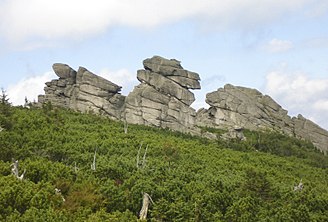Końskie Łby
| Końskie Łby German horse headstones , Czech Koňské hlavy |
|
|---|---|
| Basic geotopic data | |
| Geotope type | Granite outcrop |
| Terrain height | 1290 m |
| Size (L × W × H) | approx. 70 × 30 × 15 m |
| location | Lower Silesia , Poland |
| Geological unit (s) | Silesian ridge → Giant Mountains |
| Municipality / city | Szklarska Poręba ( Schreiberhau ) |
| Coordinates | 50 ° 47 '48.2 " N , 15 ° 30' 45.3" E |
Końskie Łby (German horse headstones , Czech Koňské hlavy ) is the Polish name for a group of three granite rocks in the western part of the Silesian Ridge of the Giant Mountains in Poland .
location
The rocks lie at an altitude of approx. 1290 m above sea level on the edge of a flattening below the summit on the north side of the frost carrier (Polish Szrenica , Czech Jínonoš - 1362 m). Thanks to its height of up to 15 feet they are of Szklarska Poreba (Schreiberhau) comprising about 3 km at the foot of the mountain is good to be seen before the Reifträgerbaude.
Names
The translations from Polish and Czech speak of “horse heads”, unlike in German in the plural form, although only one of the rocks has a marked resemblance to a horse's head. Either way, a legend has formed around the shape. It says that a robber baron and his horses were turned into stones and scattered over the Giant Mountains as punishment for his dishonorable deeds.
Emergence
But there are also other explanations for the many, mostly heavily jagged rock outcrops that can be found along the Silesian Ridge. The current shape of the rocks is the result of complex and long-lasting processes, which are characterized by extensive removal of surface rock and the subsequent weathering of the deep rock .
Especially during the last ice age , repeated freezing and thawing of the water between the cracks in the rock resulted in ever deeper gaps along the natural break lines. These occur at right angles in the so-called orthogonal fissure system and lead to the weathering of wool sacks that is typical of the Giant Mountains .
The alternating freezing and thawing also affected the layers of soil above the permafrost and led to a phenomenon known as "soil flow" , which was responsible for the removal of the rock material broken up by the frost blasting down the slope. This explains why the rocks as outcrops - to put it in layman's terms - remained isolated. Geomorphologically, the rock formation is assigned to the Tor type (it is named after the rock towers called Tors in Dartmoor / England ).
Tourism and nature protection
The rock group is surrounded on all sides by mountain pines and is located in the area of the Polish national park Karkonoski Park Narodowy (KPN). This means, among other things, that paved paths must not be left, but climbing is not even necessary. The horses' heads offer a wide panorama over the Jizera Mountains , Szklarska Poręba and the large valley basin of the Hirschberg Valley (Kotlina Jeleniogórska in Polish). They are therefore among the most visited rocks in the Giant Mountains.
The hiking trails in the area are marked:
▬ Schwarz - this trail leads to the Reifträgerbaude 400 m away.
▬ Marked in green, a path comes from Jakuszyce ( Jakobsthal ) over the “Hala Szrenicka” ( border meadow ) located 800 m to the north-west and continues to the summit of the Reifträger. If you come to the end of the path, you will come across the red marked ridge path .
▬ Red - the path with this sign is also called the “ Path of Polish-Czech Friendship ” and leads east to the Trzy Świnki ( German Saussteine , Czech Svinské Kameny ), another rock formation nearby.
